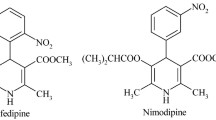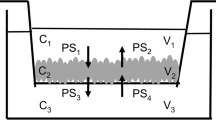Abstract
Purpose. To develop a rapid and reliable system for affinity determination of conventional as well as newly synthesized compounds to P-gp.
Methods. The principles of radioligand-binding assay were adapted to the human intestinal P-gp. Acceptor protein was obtained from the human carcinoma cell line Caco-2, where overexpression of P-gp was induced by growing cells in the presence of the cytostatic drug vinblastine. 3H-Verapamil was chosen as radioligand.
Results. The saturability and specificity of 3H-verapamil as the radioligand for the binding to P-gp was demonstrated. From concentration dependence of displacement of the radioligand by various non-labeled ligands for P-gp, affinity constants to P-gp binding sites were calculated. The binding results obtained were in agreement with those published earlier where influx and efflux experiments with cell monolayers had been conducted in order to functionally characterize the P-gp -drug interaction.
Conclusions. A radioligand-binding assay on the basis of P-gp overexpressing Caco-2 cells has been developed. The method might be suitable for high-throughput screening of drug interaction with human P-gp. It will allow modeling of the interaction of drugs with the human multi-drug transporter and has also the potential to serve as a high-throughput screening tool to detect compounds prone to P-gp mediated intestinal secretion and potential P-gp related drug/drug interactions in drug discovery and early development.
Similar content being viewed by others
REFERENCES
F. Thiebaut, T. Tsuruo, H. Hamada, M. M. Gottesman, I. Pastan, and M. C. Willingham. Cellular localization of the multidrug-resistance gene product P-glycoprotein in normal human tissues. Proc. Natl. Acad. Sci. USA 84:7735–7738 (1987).
J. Hunter, M. A. Jepson, T. Tsuruo, L. Simmons, and B. H. Hirst. Functional expression of P-glycoprotein in apical membranes of human intestinal Caco-2 cells. J. Biol. Chem. 20:14991–14997 (1993).
U. Wetterich, H. Spahn-Langguth, E. Mutschler, B. Terhaag, W. Rösch and P. Langguth. Evidence for the intestinal secretion as additional clearance pathway of talinolol enantiomers: Concentration-and dose dependence of absorption in vitro and in vivo. Pharm. Res. 13:514–522 (1996).
T. Gramatté, R. Oertel, B. Terhaag, and W. Kirch. Direct demonstration of small intestinal secretion and site-dependent absorption of the β-blocker talinolol in humans. Clin. Pharmacol. Ther. 59:541–549 (1996).
H. Spahn-Langguth, G. Baktir, A. Radschuweit, A. Okyar, B. Terhaag, P. Ader, A. Hanafy, and P. Langguth. P-Glycoprotein transporters and the gastrointestinal tract: Evaluation of the potential in vivo relevance of in vitro data employing talinolol as model compound. Int. J. Clin. Pharmacol. Ther. 36:16–24 (1998).
B. Sarkadi, M. Müller, L. Homolya, Z. Hollo, J. Seprodi, U. A. Germann, M. M. Gottesman, E. M. Price, and R. C. Boucher. Interaction of bioactive hydrophobic peptides with human multidrug transporter. FASEB J. 8:766–770 (1994).
M. K. Al-Shawi and A. E. Senior. Characterization of the Adenosine Triphosphatase Activity of Chinese Hamster P-glycoprotein. J. Biol. Chem. 268:4197–4206 (1993).
B. Sarkadi, E. M. Price, R. C. Boucher, U. A. Germann, and G. A. Scarborough. Expression of the human multidrug resistance cDNA in insect cells generates a high activity drug-stimulated membrane ATP-ase. J. Biol. Chem. 267:4854–4858 (1992).
I. L. Urbatsch and A. E. Senior. Effects of lipids on ATPase activity of purified Chinese hamster P-glycoprotein. Arch. Biochem. Biophys. 316:135–140 (1995).
H. Spahn, A. Wellstein, G. Pflugmann, and E. Mutschler. Radioreceptor assay of metoprolol in human plasma: Comparison with an enantiospecific high-performance liquid chromatographic (HPLC) procedure. Pharm. Res. 6:152–155 (1989).
P. Crevat-Pisano. Fundamental aspects of radioreceptor assays. J. Pharm. Biomed. Anal. 6:697–716 (1986).
J. Hunter and B. Hirst. Intestinal secretion of drugs. The role of P-glycoprotein and related drug efflux systems in limiting oral drug absorption. Adv. Drug Deliv. Rev. 25:129–157 (1997).
S. Ymer and D. A. Jans. In Vivo Chromatin Structure of the Murine Interleukin-5 Gene Region: A New Intact Cell System. Bio Techniques 20:834–840 (1996).
M. Horio, M. M. Gottesman, and I. Pastan. ATP-dependent transport of vinblastine in vesicles from human multidrug-resistant cells. Proc. Natl. Acad. Sci. USA 85:3580–3584 (1988).
P. R. Twentyman, T. Rhodes, and S. Rayner. A Comparison of Rhodamine 123 Accumulation and Efflux in Cells with P-glycoprotein-mediated and MRP-associated Multidrug Resistance Phenotypes. Eur. J. Cancer 30A:1360–1369 (1994).
G. Champigny, B. Verrier, and M. Lazdunski. Ca2+ channel blockers inhibit secretory C1-channels in intestinal epithelial cells. Biochem. Biophys. Res. Commun. 171:1022–1028 (1990).
J. A. Nelson, A. Dutt, L. H. Allen, and D. A. Wright. Functional expression of the renal organic cation transporter and P-glycoprotein in Xenopus laevis oocytes. Cancer Chemother. Pharmacol. 37:187–189 (1995).
J. Karlsson, S.-M. Kuo, J. Ziemniak, and P. Artursson. Transport of celiprolol across human intestinal epithelial (Caco-2) cells: mediation of secretion by multiple transporters including P-glycoprotein. Br. J. Pharmacol. 110:1009–1016 (1993).
J. Hunter and W. H. Hirst. Intestinal secretion of drugs. Role of P-glycoprotein and related drug efflux systems in limiting oral drug absorption. Adv. Drug Delivery Rev. 25:129–158 (1997).
G. A. Scarborough. Drug-Stimulated ATPase Activity of the Human P-glycoprotein. J. Bioenerg. Biomembr. 27:37–41 (1995).
P. R. Twentyman, T. Rhodes, and S. Rayner. A comparison of Rhodamine 123 accumulation and efflux in cells with P-Glycoprotein-mediated and MRP-associated multidrug resistance phenotypes. Eur. J. Cancer 30A:1360–1369 (1994).
M. P. Draper, R. L. Martell, and S. B. Levy. Active efflux of the free acid form of the fluorescent dye 2′,7′-bis(2-carboxyethyl)-5(6)-carboxyfluorescein in multidrug-resistance-protein-overex-pressing murine and human leukemia cells. Eur. J. Biochem. 243:219–224 (1997).
J. W. Wells. Analysis and interpretation of binding at equilibrium. In: E.C. Hulme (ed.) Receptor-Ligand Interactions, IRL Press, Oxford (1992), pp. 288–394.
T. Kenakin. Radioligand binding experiments. In: Pharmacological Analysis of Drug-Receptor Interaction. Raven Press, New York, (1993), pp. 385–411.
B. B. Hoffmann, and R. J. Lefkowitz. Radioligand binding studies of adrenergic receptors: new insights into molecular and physiological regulation. Annu. Rev. Pharmacol. Toxicol. 20:581–608
Author information
Authors and Affiliations
Rights and permissions
About this article
Cite this article
Döppenschmitt, S., Spahn-Langguth, H., Regårdh, C.G. et al. Radioligand-Binding Assay Employing P-Glycoprotein-Overexpressing Cells: Testing Drug Affinities to the Secretory Intestinal Multidrug Transporter. Pharm Res 15, 1001–1006 (1998). https://doi.org/10.1023/A:1011965707998
Issue Date:
DOI: https://doi.org/10.1023/A:1011965707998




